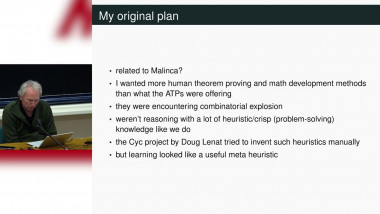
Some remarks about machine learning and (un)natural proving
By Josef Urban
Appears in collection : 2022 - T1 - WS1 - Tissue growth and movement
The goal of this presentation is the detailed asymptotic analysis of a simple integrodifferential for a structured population growing logistically, through $$\frac{\partial n}{\partial t}(t, x) = (r(x) − \rho(t)) n(t, x)$$ where the coupling comes from the total mass $\rho(t) := \int_\Omega n(t, x) dx$. These equations are well-known to lead to concentration where the fitness function r reaches its maximum, i.e., any limit point $n^\infty$ is a sum of Dirac masses located on arg max($r$) [1].
However, if and how the limit depends on the initial condition is less clear. Thanks to Laplace’s formula, I will explain how the limit measures (and more generally the asymptotics) can completely be characterised, and how they depend both on the initial condition as well as the local concavity of $r$ at the maximum points.
Alternatively, one can use a vanishing viscosity approach by adding a small mutation term $\varepsilon \Delta$. The asymptotic behaviour of the resulting PDE is easily analysed, and one recovers uniqueness for the limit $n^\infty_\varepsilon$. One may then pass to the limit $\varepsilon \rightarrow 0$ to find that the limit measure $n^\infty$ also is concentrated on arg max($r$). In contrast with the initial approach, semi-classical analysis shows that $n^\infty$ is typically unique and with a single Dirac mass.
All these results have been obtained in collaboration with Tommaso Lorenzi from Politecnico di Torino and may be find in [2]. Finally and if time permits, I’ll present some early results on adding an advection term to the integro-differential equation (PhD work of Jules Guilberteau, together with Nastassia Pouradier Duteil, Sorbonne Université).
